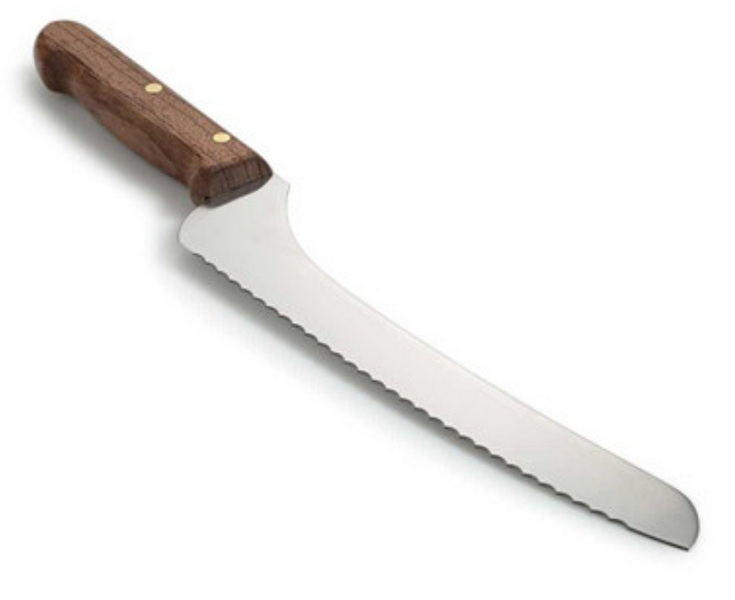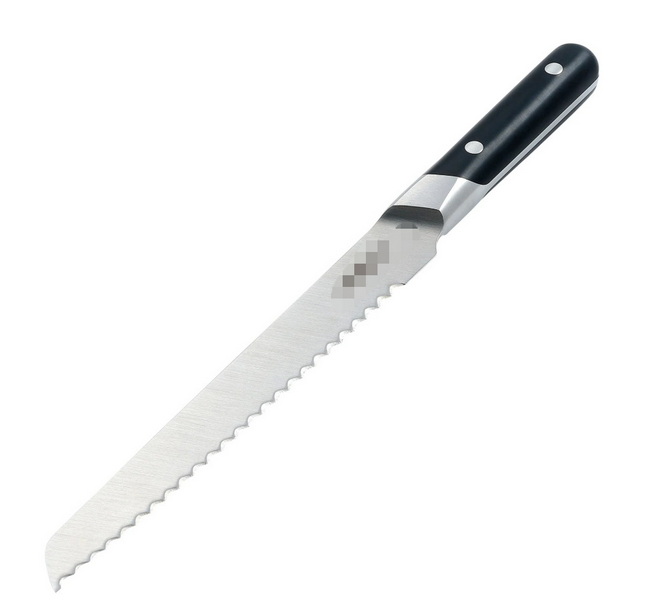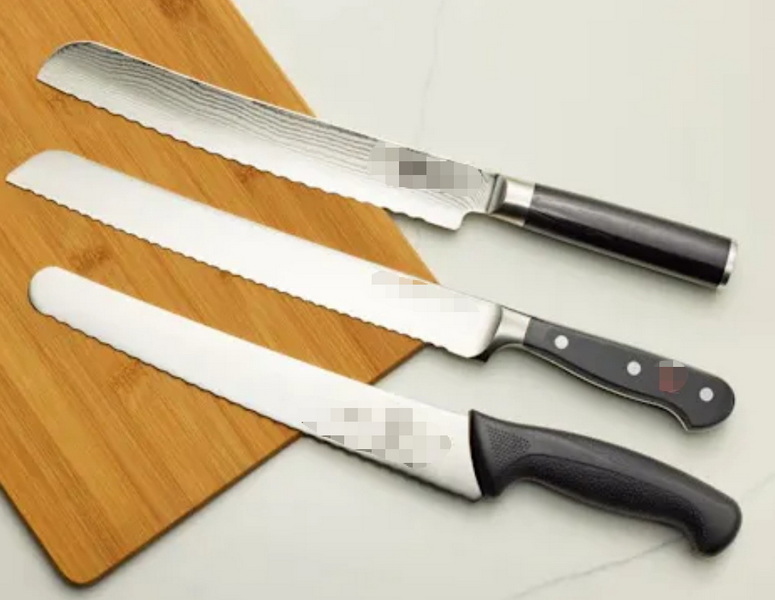- All
- Product Name
- Product Keyword
- Product Model
- Product Summary
- Product Description
- Multi Field Search
Views: 222 Author: Ann Publish Time: 2025-11-06 Origin: Site











Content Menu
● Why Is a Bread Knife Essential?
● Understanding Bread Knife Anatomy
>> 1. Traditional Serrated Bread Knives
>> 2. Double-Serrated Bread Knives
>> 3. Offset Handle Bread Knives
● How to Use a Bread Knife Effectively
>> Pro Tips:
● Bread Knife Applications Beyond Bread
● How to Evaluate Quality in OEM Bread Knives
● Bread Knife Care, Sharpening & Maintenance
● Buying Tips: Bread Knives for Every Situation
● Key Innovations in Modern Bread Knives
● Frequently Asked Questions (FAQ)
>> 1. What makes a bread knife superior to other kitchen knives?
>> 2. How do I select the best length for a bread knife?
>> 3. Can a bread knife be sharpened?
>> 4. Which bread knife blade material is best?
>> 5. Is it worth investing in premium or branded bread knives for OEM manufacturing?
Bread knives are an indispensable part of every well-appointed kitchen—be it for a budding home baker or a seasoned restaurant chef. If you're a first-time buyer, selecting the ideal bread knife might seem daunting. This guide will demystify the options, showcase key features to look for, explain proper usage and care, and give actionable recommendations for sourcing the best bread knives, especially if you're working with an OEM partner for your brand.

A bread knife is engineered to cut bread with minimal crushing or tearing. The distinct feature is its long, sharp, serrated blade—a design that bites into crusty baguettes, rustic boules, or soft sandwich loaves with equal ease while maintaining the loaf's interior texture. Unlike a chef's knife, whose straight edge may squash or tear, a bread knife preserves your bread's structure and visual appeal. This tool is equally adept at slicing cakes, pastries, and even tricky produce like tomatoes or citrus, making it a versatile kitchen addition.
A quality bread knife's anatomy determines both user experience and finished results:
- Blade: The main cutting component, generally between 7-10 inches. High-carbon stainless and premium Japanese steels are most prized.
- Serrations: These are the “teeth” that do the majority of the work, either in pointed, wavy, or double-serrated patterns.
- Curve: Many expert bread knives offer a subtle blade curve to help maintain knuckle clearance and support a natural, rocking motion.
- Tang: A full tang (where the blade steel extends through the handle) delivers superior strength and safety.
- Handle: Should offer a comfortable, non-slip grip, ideally ergonomically designed for fatigue-free cutting.
This is the classic design, characterized by a straight or gently curved blade and large, pointed serrations. These knives are best for rustic loaves with tough crusts and soft interiors.
With both large and fine serrations, these knives provide smoother, cleaner cuts—especially on soft, sticky, or crusty baked goods. Many professionals regard these as ideal for versatility and edge longevity.
Offset designs improve hand comfort and safety, keeping knuckles clear of the cutting surface during thick slicing jobs. This makes them popular for high-volume baking or foodservice use.
A gentler wave replaces the pointed serrations of a traditional blade, proving less aggressive on soft breads and pastries, but sometimes requiring more precision on hard crusts.
Handy for travel or outdoor dining, these knives hustle portability with the function of a full-sized blade.
Selecting the best bread knife isn't just about style—it's also about performance, safety, and longevity. Consider the following:
- Blade Length: 8-10 inches is ideal—long enough for big loaves but manageable for daily use. Longer blades allow for broader, smoother slicing motions.
- Blade Material: High-carbon stainless steel is the gold standard, balancing durability, sharpness, corrosion resistance, and easy maintenance.
- Serration Style: Pointed serrations grip thick crusts, wavy edges are gentle on soft bread, and double-serrated edges balance both worlds.
- Weight and Balance: A moderately heavy knife offers stability without causing hand fatigue. Well-balanced construction supports accuracy and efficiency.
- Handle Design: Ergonomic, textured handles provide a secure grip even with wet hands. Full tangs enhance safety and control.
- Flexibility: Slight flexibility aids maneuverability, allowing the blade to glide through both hard and soft foods.
1. Place your loaf on a stable cutting board.
2. Grip the handle comfortably with your dominant hand.
3. Start with the tip of the blade at the near end of the loaf.
4. Saw gently, using the full length of the blade for each back-and-forth stroke.
5. Avoid downward pressure; the serrations are meant to do the work.
6. Guide the bread with your opposite hand, keeping fingers safely positioned.
- Let the bread cool before slicing.
- Clean the blade between slices for ultra-soft breads or cakes to get perfectly neat cuts.

The bread knife shines in roles beyond its namesake:
- Slicing tomatoes and other delicate produce
- Dividing large cakes without tearing
- Portioning sandwiches or paninis
- Carving roasts or tender meats with a crusty exterior
This versatility makes a quality bread knife a true multipurpose kitchen tool.
For OEM customers choosing a manufacturing partner, quality is non-negotiable:
- Request material certificates and sample blades for third-party testing.
- Check for full tang construction and consistent, clean serration finishing.
- Inquire about edge retention testing and blade hardness ratings (ideally HRC 56-60).
- Inspect handle attachment—verify resistance to loosening or cracking over repeated use.
- Prioritize factories with robust quality control and pre-shipment inspections to ensure batch consistency.
Maintaining your bread knife will keep it performing at its best for years:
- Hand Wash Only: Avoid dishwashers; use mild soap and warm water, drying promptly with a towel.
- Specialized Sharpening: Serrated knives need a ceramic rod or specialty sharpener—usually only once or twice a year, depending on use.
- Regular Cleaning: After handling especially sticky breads or cakes, clean the blade to prevent buildup in the serrations.
- Safe Storage: Store in a knife block, magnetic strip, or sheath to protect the edge from nicks and wear.
- Only slice bread on a non-slip cutting board.
- Use a slow, steady motion and keep your free hand stable, fingers bent away from the cutting line.
- Don't use a bread knife for prying or chopping hard items.
- Store out of children's reach and never leave knives loose in a drawer.
- For Home Cooks: A mid-range, 8-9 inch serrated bread knife offers the best value and versatility.
- For Professionals: Invest in premium Japanese or German bread knives with robust, double-serrated edges for daily heavy use.
- For Gifting: Opt for visually appealing models with uncommon handle woods or artisan finishes.
- For OEM Orders: Seek flexibility in blade design, private labeling, and packaging customization to build brand identity.
Recent years have seen innovations such as:
- Non-stick coatings to reduce drag and residue
- Integrated slicing guides for precision thickness
- Composite handles for enhanced grip and dishwasher safety
- Unique blade geometries for specialized breads (e.g. ultra-deep serrations for artisan boules or thin, scalloped serrations for pastries)
Choosing the right bread knife can transform both your cooking experience and finished results. As a first-time buyer, remember that performance hinges on blade material, serration type, handle comfort, and attention to craft. With proper care, a quality bread knife becomes a kitchen companion that brings out the best in your baking and elevates your branding as an OEM supplier. Always prioritize quality, test for feel and function, and invest in a knife—or line of knives—that delivers safe, dependable, and beautiful results for years to come.

A bread knife's long, serrated blade is uniquely suited to cut through both tough crusts and soft interiors without crushing or tearing, which is hard to achieve using straight-edged knives.
Blades between 8 and 10 inches are most versatile—long enough for standard loaves yet maneuverable for smaller bread and pastries.
Yes, but maintain the serrated edge using a ceramic rod or professional service. Most quality knives only require sharpening 1-2 times per year with typical home use.
High-carbon stainless steel is preferred for edge retention, durability, and rust resistance.
Absolutely. Premium materials, precision manufacturing, and customizable features ensure your brand stands out and provides value to end users—critical for building loyalty and trust in global markets.
The Ultimate Professional Knives for Halal Butchery in Middle Eastern Kitchens
Chef Knife Size Guide: Choosing Between 6″, 8″, 10″, And 12″
Custom Knife Handles: How To Design A Chef Knife That Fits Your Hand Perfectly
Chef Knife Surface Treatments Guide: From Polished Migaki To Damascus Patterns
Inside Our Professional Knife Sample Room: Quality You Can See
Universal Knife Block Buying Guide: Modern Acrylic & ABS Knife Holders for Professional Kitchens
Universal Knife Block: The Complete Guide To Modern, Hygienic Knife Storage
The Complete Guide To Red Handle Knife Sets: Style Meets Functionality in The Kitchen
Professional Knives for Halal Butchery And Middle Eastern Cuisine